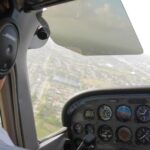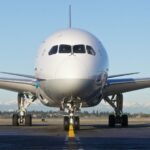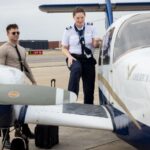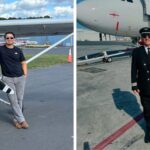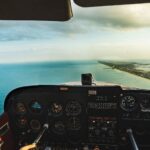When I was a kid growing up in the ‘60s and ‘70s, we would try to find any kind of toy that could fly. One of the toys that our parents bought for us was a control line airplane. You started a gas-powered engine and stood in the middle while spinning in circles making the airplane fly and do tricks.
These were fun and occupied many hours of our day. We could fly fighters, transports, and even sport planes. You could do loops and other tricks and when you were bored you could even practice landing the airplane on the ground as softly as possible.
For us, it was the next best thing to flying an actual airplane. This toy only fueled our passion for flying the real deal.
As we got older, the little string airplane was simply not doing it for us. There had to be something different, another option that was more lifelike. Magazines were our escape. Our local candy store began selling magazines with articles about remote control airplanes. The first of these remote control airplanes were very simple and offered different combinations of control. The most basic of the airplanes only had an elevator and rudder control. You had to wait for the engine to run out of gas before you could land. As we grew older, the sophistication of these RC airplanes increased as well.
By the time I was in college, we had customized servo controls so we could tweak the performance and response of the engines and control surfaces. We would connect two remotes together so we could teach a newbie how to fly his airplane without destroying or losing it.
In the last couple of years, as drones came on the market, many of us in our 50’s and 60’s could not understand why people were referring to them as “new”. We had been flying remote control airplanes for years.
Being the curious person that I am, I had to find out what was so special about these new drones. So, I bought one. It didn’t take long to determine that this wasn’t my RC airplane from 40 years ago.
When we flew RC airplanes, it was usually at an RC airport which was out of range from real airplanes and airports. The reach of the airplanes was limited primarily to the immediate surrounding area. Many of the RC pilots were trained by other RC pilots and there was some semblance of operating protocol at these airports.
Today, anyone can buy a drone, charge it, and fly it out of their backyard. Remote control units have been replaced by
smartphones. Radio frequency chips have been replaced by Bluetooth and Wi-Fi controllers. The need for training has been replaced by the “auto land” and “auto takeoff” buttons. There are cameras and onboard navigation computers in case you inadvertently fly it out of range. While all these advancements are great, they can wreak havoc on real airplane operations. Many of today’s “personal” drone pilots don’t take the time to educate themselves on how to safely operate one. The instantaneous gratification of bringing it home and flying it far outweighs the need for safety considerations. I am not talking about cutting off a finger or losing an eye, but rather about flying the personal drones in the same airspace as real airplanes, and this could be potentially life-threatening.
It didn’t take long for these incursions to catch the attention of the FAA. To provide some sort of basic communication for this new crop of drone operators, the FAA requested that everyone who purchases a drone register it with the FAA. To date, over 820,000 people have registered their drones in the United States. For comparison purposes, there are just slightly over 220,000 airplanes registered in the United States. Going one step further, the FAA even made it easy for operators to obtain their Remote Pilot Certificate.
Drones are fun to fly and serve many practical purposes. However, when the pilot flying the drone is irresponsible or does not take the serious hazards that can be introduced into the national airspace system into consideration, critical safety issues can arise.
FAA Drone Regulations
The Federal Aviation Regulation covering drone operations is Part 107. There are many restrictions that apply to drones.
These include:
Stadium and Sporting Events – Drone operation is not permitted one hour before to one hour after any Major League Baseball, National Football League or NCAA Division One Football games. This also includes NASCAR, Sprint Cup, Indy Car, and Champ Series races.
Near Airports – ATC permission required before flying into controlled airspace. You must notify the airport operator and ATC if you are going to fly a drone within 5 miles of an airport.
Security Sensitive Airspace Restrictions – Drones cannot be operated over Military Bases and DOD facilities, National Landmarks or certain critical infrastructure structures such as nuclear power plants.
Restricted or Special Use Airspace – Drones cannot be operated without special permission in Prohibited and Restricted areas and operations are specifically outlined in TFR’s.
Washington, DC – Drones are not permitted to operate within a 30-mile radius of the Ronald Reagan Washington National Airport.
Emergency and Rescue Operations including Wildfires and Hurricanes – Drones are not permitted to be operated without special permission around Emergency Rescue Operations or Hurricanes.
As a pilot, you can protect yourself by making sure you obtain all the available NOTAMS about drone activity along your route of flight. You can also make it safer for other pilots by reporting drone activity around the airport to the FAA and the authorities.
DRONE SAFETY TIPS
1. Register your drone
2. Fly your drone at or below 400 feet
3. Keep your drone within your line of sight
4. Be aware of FAA Airspace Restrictions
5. Respect privacy
6. Never fly near other aircraft, especially near airports
7. Never fly over groups of people, public events, or stadiums full of people
8. Never fly near emergencies such as fires or hurricane recovery efforts
9. Never fly under the influence of drugs or alcohol






